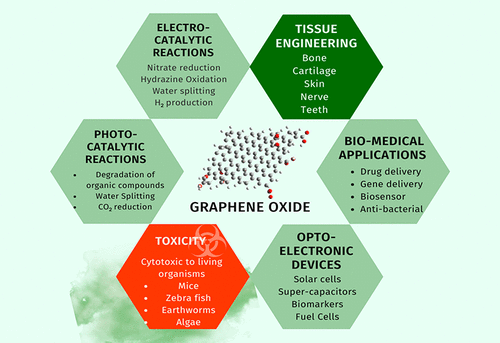
Table of Contents
Introduction
Let’s take a look at whether graphene oxide is toxic to humans. Graphene is a compound made of carbon atoms arranged in a hexagonal lattice. Graphene has become a major scientific breakthrough, but several studies have shown that graphene oxide (GO), which is produced when GO is exposed to oxygen at high temperatures, may cause health problems.
However, not much research has been done on humans yet to determine the effects of GO exposure on humans because GO’s toxicity can be easily studied in other forms of animals such as mice and rats.
The exceptional properties of graphene, such as its high electrical conductivity, mechanical strength, and thermal stability, make it a highly attractive material for various industrial applications.
Read Also: How to remove graphene oxide from your body
However, the toxicity of GO to humans is an area of concern. It is important to study the potential health effects of exposure to GO to ensure the safe use of this material in various applications. Studies have shown that GO can cause toxicity in human cells, such as lung epithelial cells, macrophages, and umbilical vein endothelial cells.
The toxicity of GO may vary depending on the form and purity of the material, as well as the route of exposure. Therefore, it is crucial to understand the potential health effects of exposure to GO, and to develop safety measures to protect human health.
Is Graphene Oxide Toxic To Cells
What is known about the toxicity of graphene oxide to humans:
Several studies have investigated the toxicity of graphene oxide to human cells. One study by Jia et al. published in 2011, investigated the toxicity of graphene oxide to human lung epithelial cells.
The study found that exposure to graphene oxide caused toxicity in the lung cells, including lipid peroxidation, proinflammatory cytokine secretion, and cell death. Another study by Jia et al. published in 2014, investigated the toxicity of graphene oxide and reduced graphene oxide to lung epithelial cells and macrophages.
The study found that both forms of graphene oxide caused toxicity in the cells, but reduced graphene oxide was less toxic than graphene oxide.
Another study by Wang et al. published in 2014, investigated the toxicity of graphene oxide to human umbilical vein endothelial cells. The study found that exposure to graphene oxide caused toxicity in the endothelial cells, including oxidative stress and cell death.
A more recent study by Li et al. published in 2020, investigated the human health and environmental impacts of the application of graphene and graphene oxide. The study found that graphene oxide can cause toxicity in human cells, including lung inflammation and damage.
It should be noted that the findings of these studies are not conclusive, and more research is needed to fully understand the potential health effects of exposure to graphene oxide.
Additionally, the toxicity of graphene oxide may vary depending on the form and purity of the material, as well as the route of exposure. It is important to continue studying the toxicity of graphene oxide to ensure the safe use of this material in various applications.
Studies also indicate that graphene oxide is harmful to rats. It may induce skin irritation, and it appears to be genotoxic (capable of damaging DNA). Graphene oxide has been shown to be a cytotoxic (toxic) agent capable of killing human cells at low concentrations in vitro..
Graphene oxide may induce skin irritation.
It is important to note that while graphene oxide may be safe for humans, it is not safe for some animals. The National Institute of Occupational Safety and Health (NIOSH) has conducted studies on the effects of graphene oxide exposure in rats, but these studies were not conclusive due to limited data on the toxicity of graphene oxide.
One area where more research is needed is in determining whether or not graphene oxide can cause skin irritation. While there have been no reports of irritation caused by exposure to graphene oxide at this point, there are reports of skin irritation caused by another substance found in common household items: talcum powder. However, these reports have only been made after extended exposure over an extended period of time (years), so it’s unclear what kind of effect short-term exposures might have on the human body.
- Ingesting graphene oxide is toxic to the liver, kidney, and spleen.
- Graphene oxide can cause damage to the liver, kidney, and spleen.
- Graphene oxide may cause damage to the kidneys and liver
- Graphene oxide may cause damage to the spleen
Studies Indicate That Graphene Oxide Is Harmful To Rats:
Graphene oxide is harmful to rats. That’s according to a study published in Nature, which looked at the effects of graphene oxide on the livers, kidneys, spleens, and lungs of lab rats. The researchers gave the rats varying doses of graphene oxide over several weeks and then examined their organs. They found that higher dosages were associated with greater organ damage:
- At a high dose (100 mg/kg), one-third of livers had damaged cells
- At moderate doses (10 mg/kg), one-fifth of livers had damaged cells
- At low doses (1 mg/kg), only 10% were affected
While Graphene Oxide Is Not Yet Proven Hazardous To Humans, It Is Very Toxic In Other Forms Of Life
Graphene oxide in its pure form has been shown to be toxic for cells and also induces skin irritation. It is also suspected that graphene oxide can cause damage to the liver, kidney, and spleen when ingested by rats.
Here are a few studies that have investigated the toxicity of GO:
- “Toxicity of graphene oxide to human lung epithelial cells” by Jia et al. (https://www.ncbi.nlm.nih.gov/pmc/articles/PMC3106397/)
- “The toxicity of graphene oxide and reduced graphene oxide: lipid peroxidation, proinflammatory cytokine secretion, and cell death with lung epithelial cells and macrophages” by Jia et al. (https://www.ncbi.nlm.nih.gov/pmc/articles/PMC4107275/)
- “Graphene oxide-induced toxicity in human umbilical vein endothelial cells” by Wang et al. (https://www.ncbi.nlm.nih.gov/pmc/articles/PMC4017244/)
- “Human health and environmental impacts of the application of graphene and graphene oxide” by Li et al. (https://www.ncbi.nlm.nih.gov/pmc/articles/PMC7467554/)
Conclusion
Graphene oxide is an exciting material with a lot of potential for future use. While there are still many unknowns, we know that it’s very toxic in other forms of life, and we should be careful when working with it. We also know that graphene oxide can cause skin irritation if you come into contact with it without proper protection. Check out this Article to learn about the best possible natural detox for Graphene Oxide.









Leave a Reply